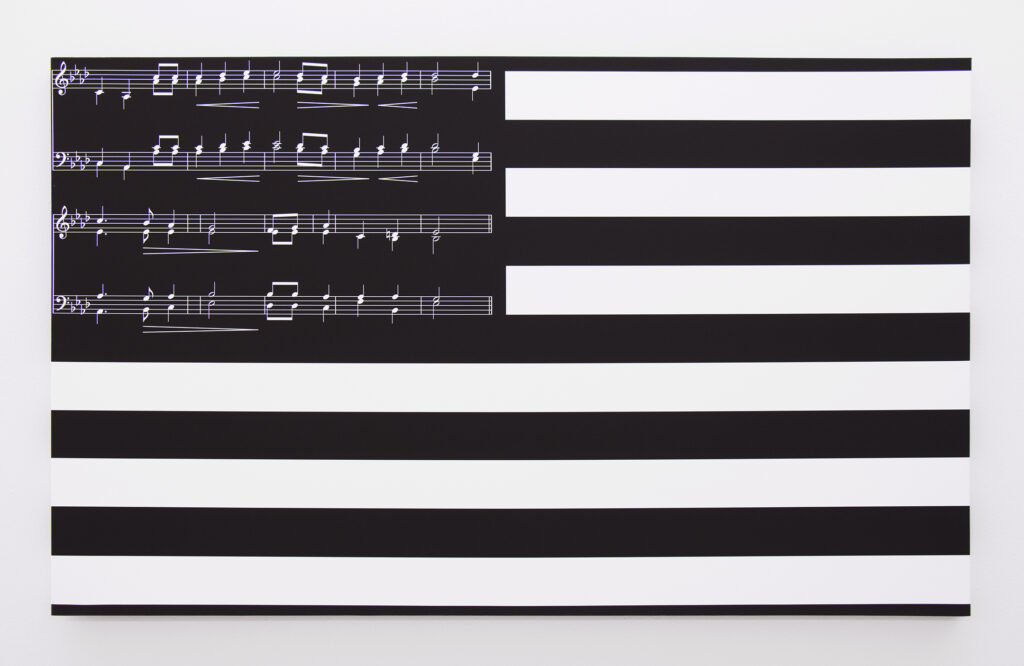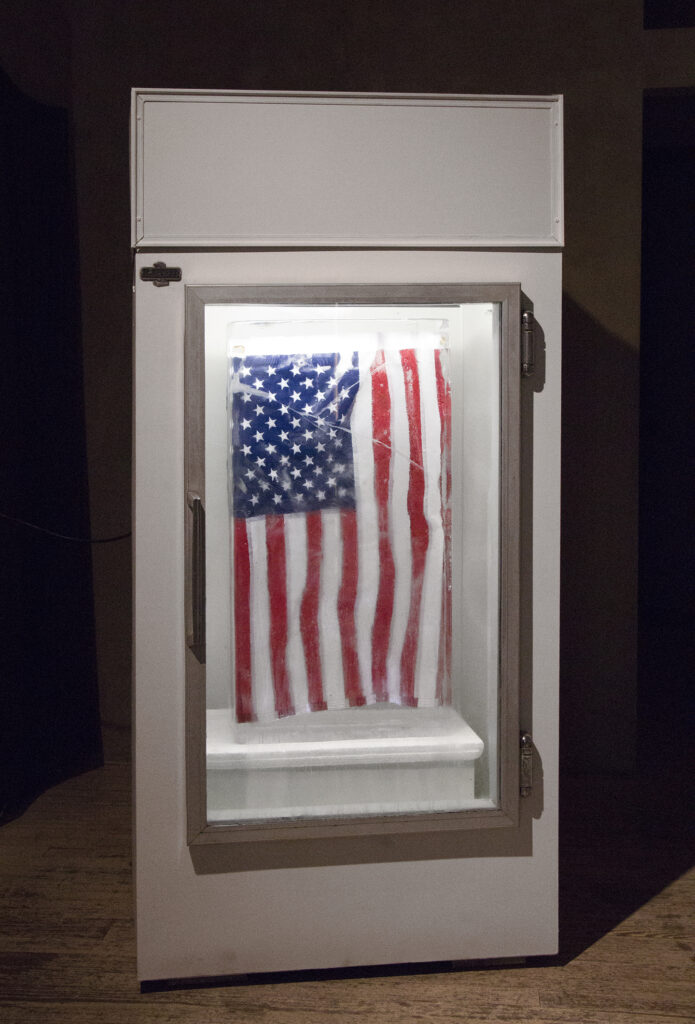Kamari Carter
Vexillary
December 19, 2024 – January 25, 2025
Opening Thursday December 19, 6-8pm

Installation Views
Press:
Hyperallergic
Microscope is very pleased to present “Vexillary” as the second solo exhibition at the gallery of works by NY-based artist Kamari Carter.
In this new body of work, Carter continues his investigation of systems of power in the US by utilizing the flag — across several mediums — as a conceptual lever to spur reflections on how the history and promise contained within its imagery corresponds to the realities of American culture and society.
The regulations behind the making of the flag — including the attention given to such details as the equality of measurements between the alternating stripes — are placed under scrutiny in several works. While in others, Carter substitutes different principles to offer other insights, interpretations, and to point to the many injustices hiding behind this emblem of national unity, the first of which was adopted on June 14, 1777 and which has remained unchanged since the addition of the 50th star on July 4th, 1960. Although centered in the history and symbolism of the flag, including at times its use in contemporary art, Carter’s focus is on the present moment of our nation, with its strongly divided populace ostensibly represented by the same flag, one that among other unprecedented misuses was found flying upside down at the residence of a sitting Supreme Court Justice.
In his “Musical Flags” series of black and white archival inkjet on canvas works, Carter reimagines the American flag as a musical score. In “Gloom of the Grave,” two lines of the musical notations for the little-known third stanza of the Star-Spangled Banner replaces the upper left-hand corner, or “Union” section of the flag. The corresponding lyrics, which do not appear in the work, read: “No refuge could save the hireling and slave / From the terror of flight or the gloom of the grave / And the star-spangled banner in triumph doth wave / O’er the land of the free and the home of the brave.” In “Whole Note Flag” a single white whole note sits alone against a black background, referencing the single-star “Bonnie Blue Flag,” which was flown at Fort Sumter in April 1861 as the Civil War began. While “A Moment of Silence,” depicts a treble staff with a 50-bar-long resting note, or pause, in place of the usual 50 stars.
“Perfidy,” a 6 x 5 ft. all-white version of the American flag hanging at an angle from a stainless steel flag pole installed on a wall, is simultaneously a sign of surrender and triumph for the intolerant or racist members of our society, with their often conflicting narratives such as claims of persecution while supporting discriminatory and repressive policies against others.
For the two lithograph diptychs “Untitled (Equal Parts)” and “Untitled (Equal Spaces)” on view, the artist re-appropriates pages from Eisenhower’s Executive Order 10834 of August 21, 1959, on the occasion of the admission of Hawaii to the United States, which contained precise instructions on how to make an American flag. In each diptych, the same image is printed on separate sheets of archival paper using black ink on one, and white ink on the other. The title uses the terminology of the original document, which refers to the flag as divided into “13 Equal Parts” and “13 Equal Spaces.”
The sound installation “Patriot Act” features three megaphones — one red, one white, and one blue — broadcasting live feeds of radio transmissions by the Metropolitan Police Department in DC (MPD), which during the show will encompass the weeks leading up to, during, and just after the Presidential Inauguration. This work draws connections between the expanded surveillance powers granted in the Patriot Act in response to 9/11, with their effects on local policing, and the contrast in their perception and responses to threats by the MPD during the Black Lives Matter Protests of June 2020, including at Lafayette Square, and on January 6, 2021, just a little over a half year later.
Finally, Carter’s installation “Frozen Flag” consists of an actual American flag frozen inside a large 2 x 3 ft. ice block, housed within a tall, commercial ice freezer, and visible through its glass door. Carter says of the work: “Ice is a byproduct of time mixed with the elements of water and oxygen. Time is something that tends to move, and when it does it moves in one direction (often forward). In Frozen Flag, the item on display (The American Flag) is frozen solid within a block of ice trapped within a moment of time, unmoving, unwaving. To this end, only conditions of change can alter or better the state of the flag, and as such the state of the country.”
“Kamari Carter: Vexillary” opens Thursday December 19, 2024 and continues through January 25, 2025, with an Opening Reception on Thursday December 19, 6-8pm. Gallery Hours: Tuesday through Saturday, 12-6pm.
_
Kamari Carter (b. 1992) is a New York-based artist working primarily with installation, video, sound, and performance to investigate notions such as space, systems of identity, oppression, control, and surveillance. His work has been exhibited at Museum of Modern Art (MoMA), New York; Perez Art Museum Miami, Miami, FL; Rhode Island School of Design (RISD) Museum, Providence, RI; Mana Contemporary, Jersey City, NJ; Flux Factory, Long Island City, NY; Wave Hill, New York; Fridman Gallery, New York; and Automata Arts, Los Angeles, among others, and has been featured in publications including Artnet, Flash Art, and Whitewall, among others. Carter received a BFA from California Institute of the Arts (CalArts), Valencia, CA in 2017 and an MFA from Columbia University in 2019.

